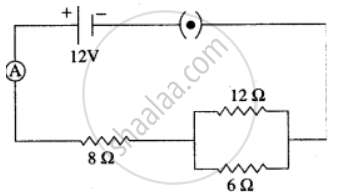Advertisements
Advertisements
प्रश्न
Exercise.
Calculate the amount of charge that would flow in 2 hours through an element of an electric bulb drawing a current of 2.5 A.
उत्तर
Given: Time ‘t’ = 2 hours = 2 × 60 × 60s
t = 7200s
I = 2.5A
Amount of charge, Q = I × t
= 2.5 × 7200
Q = 18000C
APPEARS IN
संबंधित प्रश्न
The values of current (I) flowing through a given resistor of resistance (R), for the corresponding values of potential difference (V) across the resistor are as given below:
| V (volts) | 0.5 | 1.0 | 1.5 | 2.0 | 2.5 | 3.0 | 4.0 | 5.0 |
| I (amperes) | 0.1 | 0.2 | 0.3 | 0.4 | 0.5 | 0.6 | 0.8 | 1.0 |
Plot a graph between current (I) and potential difference (V) and determine the resistance (R) of the resistor.
What is the SI unit of potential difference?
What p.d. is needed to send a current of 6 A through an electrical appliance having a resistance of 40 Ω?
If the potential difference between the end of a wire of fixed resistance is doubled, by how much does the electric power increase?
What do you understand by the resistance of a wire?
Three resistors are connected to a 12 V battery as shown in the figure given below:

(i) What is the current through the 8 ohm resistor?
(ii) What is the potential difference across the parallel combination of 6 ohm and 12 ohm resistor?
(iii) What is the current through the 6 ohm resistor?
Three resistors are connected to a 6 V battery as shown in the figure given below:

Calculate:
(i) the equivalent resistance of the circuit.
(ii) total current in the circuit.
(iii) potential difference across the 7.2 Ω resistor.
A 10 m long wire of a particular material is of resistance 5Ω What will be the resistance if the wire is doubled itself.
Electric potential is a ____________.
What is the measure of the work done on the unit positive charge to bring it to that point against all electrical forces?
